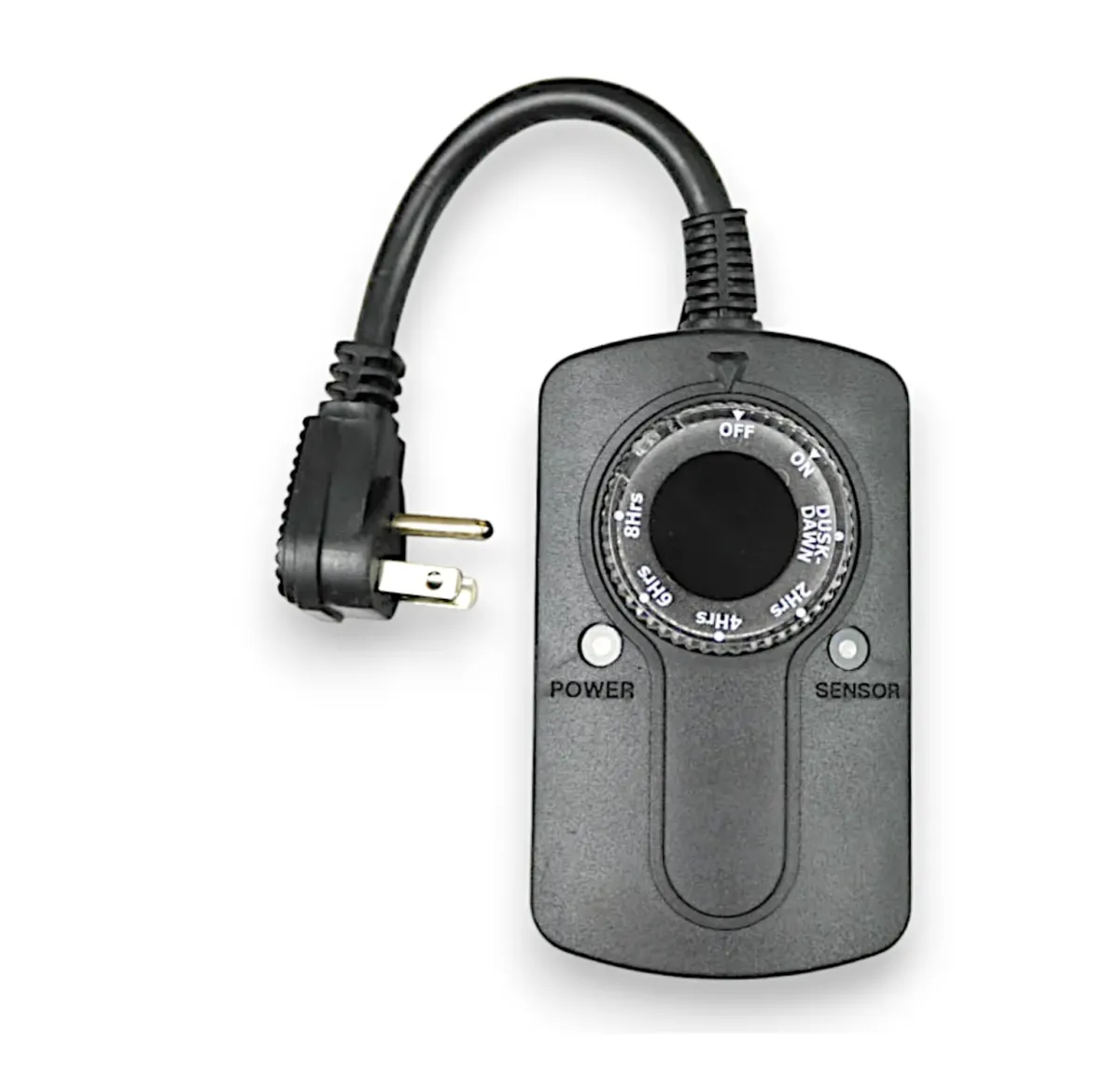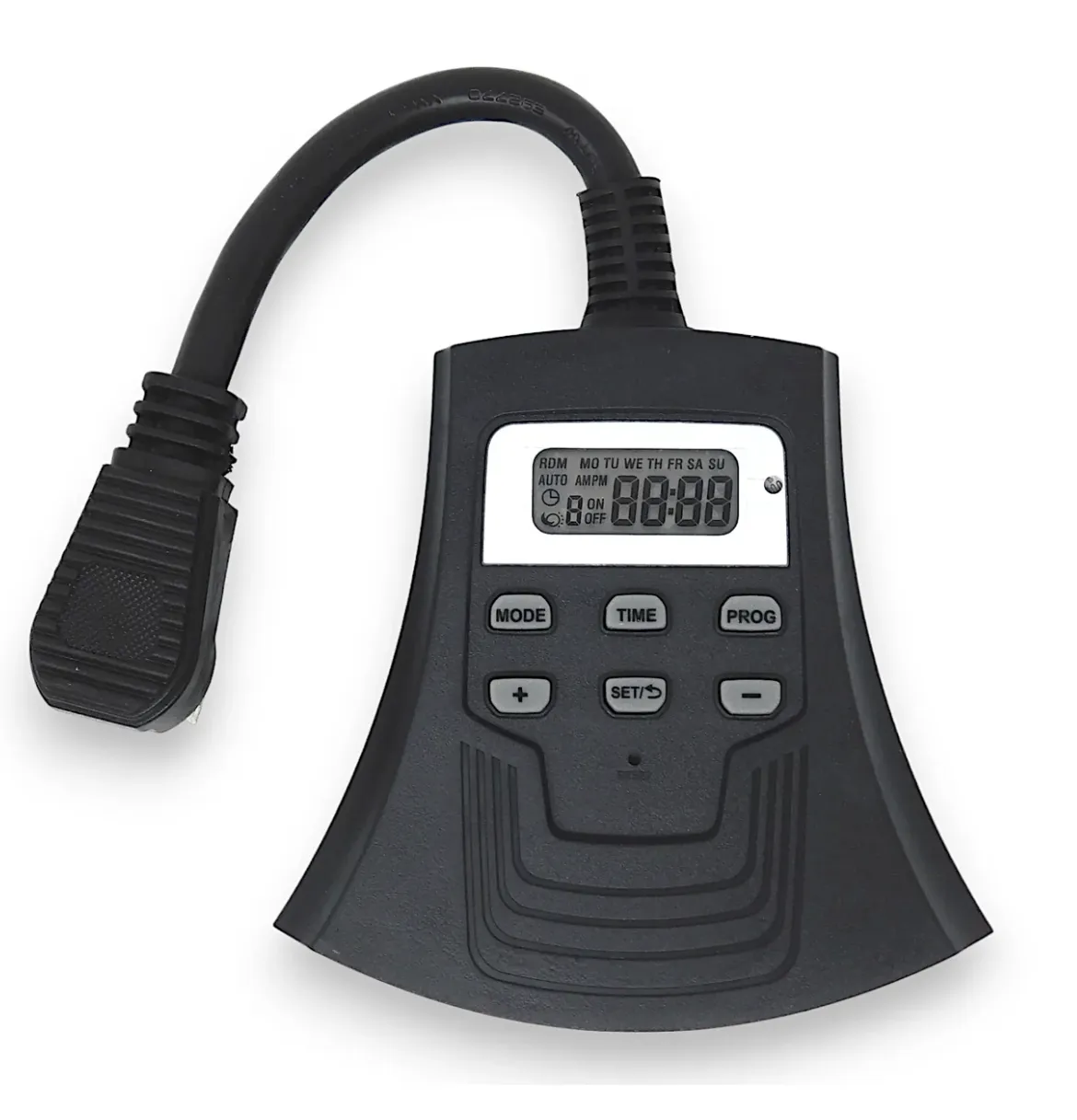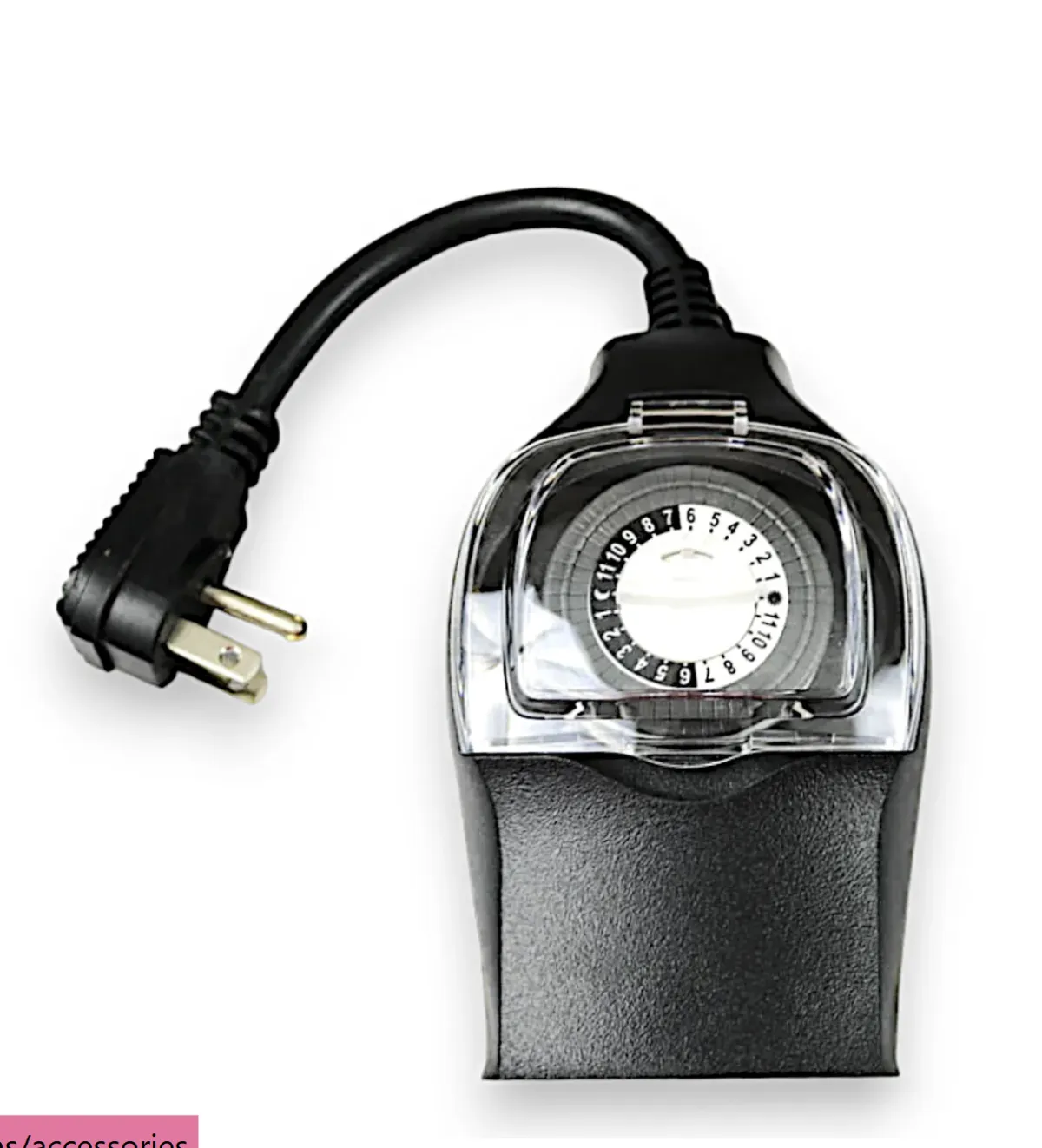Precision Control for Your Holiday Illuminations: Professional-Grade Outdoor Timers
Elevate your holiday lighting displays with our collection of professional-grade outdoor timers. These essential tools offer precise control and energy efficiency for your festive illuminations. Whether you're a professional installer or a homeowner looking to enhance your holiday decor, our range of timers provides the perfect solution for managing your lights with ease. From photo cell timers that automatically adjust to daylight changes, to digital and mechanical options offering customizable schedules, our selection ensures your displays shine at just the right times. Designed for both indoor and outdoor use, these durable timers combine convenience with reliability, helping you create magical holiday atmospheres while conserving energy. Discover how our timers can transform your lighting management and take your seasonal displays to the next level.
Timers
Photo Cell Timer
Enhance your holiday lighting control with our versatile Photo Cell Timer featuring a convenient right-angle plug. This intelligent device offers two outlets, providing flexible options for managing multiple light strings or decorations. The timer comes with a range of settings to suit your specific needs: choose between Off, On, Dusk to Dawn, or preset durations of 2, 4, 6, or 8 hours. The photo cell technology automatically detects ambient light levels, ensuring your lights turn on as darkness falls and off when daylight returns, perfect for the "Dusk to Dawn" setting. The right-angle plug design helps maximize space usage and reduces strain on your outlets. Whether you're looking to conserve energy, enhance security, or simply enjoy the convenience of automated lighting, this Photo Cell Timer is an essential tool for effortless and efficient holiday light management.
15 AMP Digital Timer
Streamline your outdoor lighting control with our efficient Mechanical Light Timer Switch Outlet. This versatile device is perfect for managing lamps, fans, garden lights, porch illumination, or holiday and Christmas displays, helping you reduce energy waste and extend the life of your decorations. The timer features customizable daily settings that you can adjust at any time, offering flexibility to match your changing needs or schedules. Built for durability, this wall-mounted timer comes with a three-prong, weatherproof design, ensuring reliable performance in various outdoor conditions. The three-switch outlet provides multiple connection options, allowing you to control several devices simultaneously. Whether you're looking to enhance security, create ambiance, or simply automate your outdoor lighting, this mechanical timer offers a user-friendly solution for effortless light management throughout the year.
Mechanical Timer
Enhance your lighting control with our versatile In/Outdoor Mechanical Timer featuring a space-saving right-angle plug. This robust device offers two outlets, allowing you to manage multiple light strings or decorations simultaneously. Designed for both indoor and outdoor use, it's perfect for holiday displays, security lighting, or everyday household needs. The 24-hour programmable cycle provides ultimate flexibility, enabling you to set precise on/off times that repeat daily. With a powerful 15-amp capacity, this timer can handle most residential lighting and small appliance loads with ease. The mechanical design ensures reliability and ease of use, with no complicated programming required. Whether you're looking to automate your Christmas lights, control patio illumination, or simply manage energy consumption, this durable and practical timer is an essential tool for efficient light management in any setting.
Frequently Asked Questions
What types of timers do you offer?
We offer a variety of timers including Photo Cell Timers with right-angle plugs, 15 AMP Digital Timers, and Mechanical Timers. Each type has unique features to suit different needs and preferences.
Are these timers suitable for outdoor use?
Yes, all of our timers are designed for both indoor and outdoor use. They are built with weatherproof features to ensure reliable performance in various outdoor conditions.
How many outlets do these timers have?
Most of our timers, including the Photo Cell Timer and the Mechanical Timer, offer two outlets. This allows you to control multiple light strings or decorations simultaneously.
What's the benefit of a Photo Cell Timer?
A Photo Cell Timer automatically detects ambient light levels, turning your lights on at dusk and off at dawn. This "Dusk to Dawn" feature provides convenient, energy-efficient operation without manual adjustments.
Can I set specific on/off times with these timers?
Yes, our timers offer programmable cycles. For instance, the Mechanical Timer has a 24-hour programmable cycle, allowing you to set precise on/off times that repeat daily. The Photo Cell Timer also offers preset durations of 2, 4, 6, or 8 hours in addition to its Dusk to Dawn setting.
Discover Expert Tips on Our Blog

$100K Christmas Light Secret: Doers Win, Learners Fail
The Christmas lighting industry presents incredible opportunities for entrepreneurs willing to move beyond learning and into action. While many business owners get stuck in endless research phases, the most successful operators understand that knowledge without implementation yields no results. This principle becomes especially critical in a seasonal business where timing and execution determine annual revenue.
The difference between those who achieve six-figure seasonal businesses and those who struggle isn't access to information—it's the willingness to take consistent, decisive action even when feeling unprepared. Success stories in this industry consistently feature individuals who started with limited experience but compensated through relentless execution and systematic improvement.
The Foundation: Mastering Installation Competency
Before scaling any Christmas lighting business, establishing personal competency in installations becomes essential. This doesn't mean performing every job personally forever, but understanding each aspect of the installation process enables effective training and quality control systems.
Successful business owners often describe the first season as intensive learning where they personally handle installations while simultaneously building customer relationships and refining operational processes. This hands-on approach creates the foundation for systematic expansion in subsequent years.
The installation phase encompasses numerous moving parts: proper equipment usage, safety protocols, aesthetic design principles, and customer communication throughout the process. Mastering these basics allows business owners to develop training materials and quality standards for future crew members.
Building Systems for Scalability
Year one typically involves the owner on every job, learning systems and establishing customer relationships. Year two often marks the transition where successful operators step back from daily installations to focus on business development, sales, and crew management. This progression requires deliberate system development rather than hoping procedures will naturally emerge.
Creating documented processes for common scenarios—single-story homes, two-story installations, commercial properties—accelerates training and maintains consistency across different crew members. These systems become especially valuable when seasonal hiring requires rapidly bringing new team members up to speed.
Overcoming Analysis Paralysis
One of the most significant barriers to Christmas lighting business success is overthinking, particularly around pricing strategies. Many operators become trapped in endless loops of questioning whether their market will support premium pricing, often seeking validation for charging less rather than focusing on value delivery.
This hesitation typically stems from fear rather than market reality. Successful businesses charge $8-12 per foot from the beginning, understanding that premium pricing enables sustainable operations while lower pricing creates a cycle of financial stress and poor service delivery.
The Pricing Mindset Shift
The energy and confidence you project during sales conversations directly impacts customer perception and willingness to pay premium prices. When business owners doubt their pricing internally, this uncertainty transmits to potential customers, making price objections more likely.
Conversely, operators who internalize their value proposition and feel confident in their pricing rarely encounter significant price resistance. They focus conversations on emotional benefits and customer outcomes rather than technical specifications or cost justifications.
Strategic Marketing for Lead Generation
Successful Christmas lighting businesses employ systematic approaches to lead generation rather than relying on single marketing channels. Testing multiple approaches—yard signs, Facebook advertising, door hangers, cold calling—provides data to optimize marketing investments.
The testing process involves running small-scale experiments across different channels, measuring results, and scaling successful approaches while discontinuing ineffective methods. This data-driven approach prevents large financial losses on unproven marketing strategies.

Yard Sign Strategy
Yard signs remain one of the most effective lead generation tools when executed properly. The key lies in simplicity and strategic placement rather than complex designs or excessive information. Effective signs contain only business name, "Christmas Lights," and a large, readable phone number.
Planning for 200-300 signs throughout October and November generates significant visibility, though some successful operators achieve substantial results with much smaller numbers through strategic placement in high-traffic areas.
Digital Marketing Integration
Facebook advertising works particularly well for Christmas lighting services because it allows precise geographic and demographic targeting. The key to successful Facebook campaigns lies in focusing on emotional benefits rather than technical features, creating ads that resonate with customers' desires for holiday magic and family memories.
Combining digital marketing with traditional methods like yard signs creates multiple touchpoints that reinforce brand awareness and generate leads from different customer segments.
Staffing Solutions and Team Building
Finding reliable seasonal help presents ongoing challenges for Christmas lighting businesses. Successful operators often recruit from related industries, particularly roofing, where workers possess relevant skills and experience seasonal slowdowns that align with Christmas lighting demand.
Roofers typically demonstrate strong work ethics, comfort working at heights, good safety judgment, and familiarity with ladder usage and roof navigation. Additionally, roofers often know each other, creating opportunities to build teams through referrals from successful initial hires.
Early Recruitment Strategies
Beginning recruitment efforts early in the year, rather than waiting until October, provides access to better candidates and time for proper training. This proactive approach prevents the common problem of scrambling for help during peak season when demand is highest.
Building relationships with roofing contractors and other seasonal workers throughout the year creates a pipeline of potential employees who understand your business needs and quality standards before the busy season begins.
Customer Retention and Business Growth
Customer retention rates in the Christmas lighting industry typically range from 80-90%, creating significant business value beyond the initial sale. This high retention rate means first-year customer acquisition efforts compound over time, making subsequent years progressively more profitable.
Successful operators implement systematic follow-up processes to maximize retention rates. This includes regular communication during the off-season, early booking incentives, and maintaining detailed customer records to ensure consistent service delivery.
The Compounding Effect
Year one focuses on learning systems and building initial customer base. Year two benefits from returning customers plus new acquisitions. Year three builds on two years of returning customers, making higher revenue targets increasingly achievable without proportional increases in marketing investment.
This compounding effect explains why many Christmas lighting businesses achieve dramatic revenue growth in years two and three despite maintaining similar operational capacity.
Scaling Beyond Personal Limits
The transition from owner-operator to business manager represents a critical growth phase requiring different skills and systems. Moving from personally handling every installation to managing crews and focusing on sales and business development demands systematic approach.
Successful scaling requires implementing quality control systems, developing training programs, and creating accountability measures to ensure service standards remain consistent as the business grows beyond direct owner involvement.
Revenue Progression Patterns
Many successful operators follow predictable revenue progression patterns: $100,000-200,000 in year one, $300,000-500,000 in year two, and $500,000-1,000,000+ in subsequent years. These increases typically result from improved systems, better pricing strategies, and expanded capacity rather than simply working more hours.
The most significant operational challenges often occur during the transition from $500,000 to $1,000,000 annual revenue, requiring additional crew members, administrative support, and more sophisticated business systems.

Avoiding Common Expansion Mistakes
Premature expansion into new geographic markets often dilutes focus and resources before maximizing potential in the initial market. Most successful operators reach $800,000-1,000,000 in annual revenue in their primary market before considering expansion.
The principle of "what you water grows" emphasizes the importance of focusing energy and resources on developing one market thoroughly rather than spreading efforts across multiple locations. This focused approach typically yields better results and stronger business foundations.
Market Maximization Strategies
Before expanding geographically, successful businesses maximize their current market through improved close rates, higher average tickets, expanded service offerings, and increased customer retention. These improvements often reveal significant untapped potential in existing markets.
Testing marketing channels systematically—increasing yard sign quantities, expanding Facebook ad spend, implementing referral programs—helps identify the optimal marketing mix for each specific market area.
Professional Development and Continuous Learning
The most successful Christmas lighting entrepreneurs invest heavily in their own development through training programs, coaching relationships, and industry education. This investment accelerates learning curves and helps avoid costly mistakes that slow business growth.
Regular skills development in sales techniques, business systems, and operational efficiency creates competitive advantages that compound over time. Recording sales conversations for self-analysis, attending industry training, and working with business coaches represent common investments among high-performing operators.
Networking and Relationship Building
Building relationships within the industry and local business community opens opportunities that extend beyond direct marketing efforts. Participation in business associations, charity events, and industry groups creates referral sources and strategic partnerships.
These relationships often prove more valuable than traditional advertising, particularly for high-value commercial accounts and affluent residential customers who make decisions based on trust and recommendations rather than price comparisons.

Q1: How long does it take to become competent at Christmas light installations?
A: Most business owners can achieve basic competency within 2-4 weeks of focused practice, but mastering efficient installation techniques typically takes a full season. The key is starting with simpler installations and gradually tackling more complex projects while developing systematic approaches to common scenarios.
Q2: What's the biggest mistake new Christmas lighting businesses make?
A: Underpricing services is the most common and damaging mistake. Many new operators charge $5-6 per foot thinking it will help them compete, but this pricing makes it impossible to build a sustainable business with proper insurance, equipment, and quality service delivery.
Q3: How do I overcome the "let me talk to my spouse" objection?
A: Ask clarifying questions like "Who's the decision maker here?" and "What specifically do you need to discuss?" This often reveals the real objection, which might be budget concerns or uncertainty about the value proposition rather than needing spousal approval.
Q4: When should I start recruiting seasonal employees?
A: Begin recruiting in January through March for the following season. This gives you access to better candidates and time for proper training. Waiting until October leaves you competing for workers when everyone else is hiring.
Q5: How do I know if I've maximized my current market?
A: You've likely maximized when increasing marketing spend in existing channels produces diminishing returns. For example, if doubling your yard signs from 100 to 200 doesn't increase leads proportionally, you may need to explore different marketing channels or expand geographically.

Q6: Should I offer contracts to guarantee customer retention?
A: Most successful operators use loyalty programs with incentives rather than contracts. Offering 10% discounts for early booking and guaranteed pricing for multiple years often achieves similar retention rates without the legal complications of contracts.
Q7: How important is it to have a professional trailer and equipment?
A: Professional appearance significantly impacts customer perception and pricing power. Investing in wrapped trailers, quality uniforms, and professional equipment helps justify premium pricing and creates marketing value through increased visibility.
Q8: What's the typical customer retention rate in this industry?
A: Well-run Christmas lighting businesses typically achieve 80-90% customer retention rates. This high retention makes the business increasingly profitable over time as new customer acquisition builds on an expanding base of returning customers.
Q9: How do I handle price objections from potential customers?
A: Focus the conversation on value and emotions rather than price. Ask about their motivations for wanting Christmas lights, emphasize the memories they'll create, and avoid detailed discussions of pricing unless specifically asked. Confidence in your value proposition reduces price objections.
Q10: When is it too late to start a Christmas lighting business for the current season?
A: It's rarely too late if you're willing to take immediate action. Some operators have started in late October and still achieved significant first-year revenue by focusing intensively on door-to-door sales and rapid execution. However, earlier starts provide more time for marketing and systematic customer acquisition.
Copyright ©2025 All Right Reserved website designed by christmaslights.io
Terms of Service / Privacy Policy
Have questions or need assistance?
Contact us at (855)619-LITE





